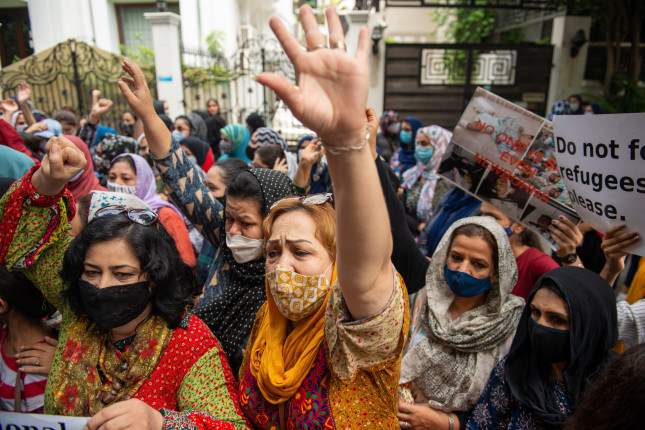-
‘Women’s Bodies are No One’s Battlefields’: Preventing War and Conflict-Related Sexual Violence
November 1, 2021 By Shruti Samala“Since time immemorial, rape has been used to control women’s sexuality, labor, and reproduction, to shred the social fabric, to conquer territories and populations, and crush the enemy’s moral and will to resist,” said Under Secretary General Pramila Patten, UN Special Representative on Sexual Violence in Conflict, at an event focused on addressing conflict-related sexual violence (CRSV) organized by The Secretary’s Office for Global Women’s Issues, Search for Common Ground, and the Georgetown Institute for Women, Peace, and Security. In the past two decades, legislative reform, sanctions against perpetrators, and systematic reporting have slowly transformed the climate of impunity surrounding CRSV, said Patten.
Yet, in 2020 the UN Office of the Special Representative of the Secretary-General on Sexual Violence in Conflict recorded more than 2,500 UN-verified incidents of CRSV. More than 96 percent of these cases targeted women and girls, and 70 percent of the incriminated parties have yet to face retributive or corrective action. “It is time to push back” against these endemic patterns of sexual violence, said Patten, and convert them into “virtuous cycle[s] of recognition, reporting, and redress, which must include accountability and reparations as a form of deterrence.”
CRSV is a widespread but avoidable consequence of war
Drawing on the Sexual Violence in Armed Conflict dataset, Robert Nagel, CRSV Expert at the Georgetown Institute for Women, Peace, and Security, highlighted three main drivers of CRSV: to induce compliance among the civilian population; to forge social bonds between combatants (who are often themselves victims of forced recruitment and abandonment); and to establish a policy of sexual violence (e.g., forced marriage and sexualized torture) wherein commanders exchange and trade women as spoils of war.
These forms of CRSV are global but not ubiquitous, said Nagel. Conflict actors wield sexual and gender-based violence strategically and opportunistically to achieve tactical gains during wartime negotiations. Sexual transgressions neither occur in every conflict, nor are they committed by every player. In some cases, conflict groups and state actors even respond to sexual violence with severe punitive measures. CRSV, said Nagel, “is not inevitable; it is preventable.”
The role of data communities and civil society
To prevent and address CRSV, multilateral bodies need to match political will with effective resourcing within peacekeeping missions, said Lisa Sharland, Adjunct Senior Fellow with the Protecting Civilians in Conflict Program at the Stimson Center.
Another core aspect of achieving this goal is developing comprehensive early warning systems that incorporate gender indexes as gender-based violence is both a consequence and precursor of mass atrocity, said Amanda Van Dort, Policy Team Lead of the Bureau of Conflict and Stabilization Operations at the U.S. Department of State. Most forecasting models of conflict employ long-term and national gender data, which fail to capture rapid fluctuations in vulnerability on the ground. The Global Framework of Gender-Sensitive Indicators for Early Warning of Violence and Conflict outlines contextually-specific gender indicators that measure community risk over shorter time periods, said Gina Chirillo, Senior Global Gender Specialist at the International Foundation for Electoral Systems. This level of data granularity, disaggregated by sex and gender, is necessary to improve the predictive capacity of early warning systems and enhance violence monitoring and prevention efforts, said Van Dort.
Ultimately, the goal of CRSV mitigation strategies is to preserve survivors’ health and wellbeing. Civil society has an important role to play in this, said Shyamala Gomez, Executive Director of the Centre for Equality and Justice. Survivor-centered approaches to tackling CRSV are vital for reparative healing, restoration, memorialization, and transitional justice. In the absence of state-led interventions, civil society actors work in close partnership with survivor-victims to deliver legal aid, psychosocial treatment, and physical security, said Gomez. Critically, said Rim Aljabi, Regional Gender Advisor at Search for Common Ground, community and civilian-led groups engage with a range of actors—government, military, media, and men—to spur societal shifts in attitude that set the bedrock for a safer, more secure, stable, and equal world for women.
Curbing the root causes of CRSV “is not only a moral imperative but also a strategic imperative,” said Rachel Vogelstein, Senior Advisor at the White House Gender Policy Council. It is time to make rape history, said Patten. “Women’s bodies are no one’s battlefields.”
Read More
- Gender-Based Violence in the DRC
- Safe From the Start: Addressing Gender-Based Violence in Times of Conflict and Crises
- Sexual Violence Beyond the Warzone, and the Relationship Between Child Marriage and Fragile States
- In Humanitarian Settings, Addressing Gender-Based Violence is Paramount
Sources: International Foundation for Electoral Systems, Journal of Peace Research
Photo Credit: Afghans at UNHCR to protest against the Taliban takeover of Afghanistan, courtesy of PradeepGaurs, shutterstock.com.
 A Publication of the Stimson Center.
A Publication of the Stimson Center.




